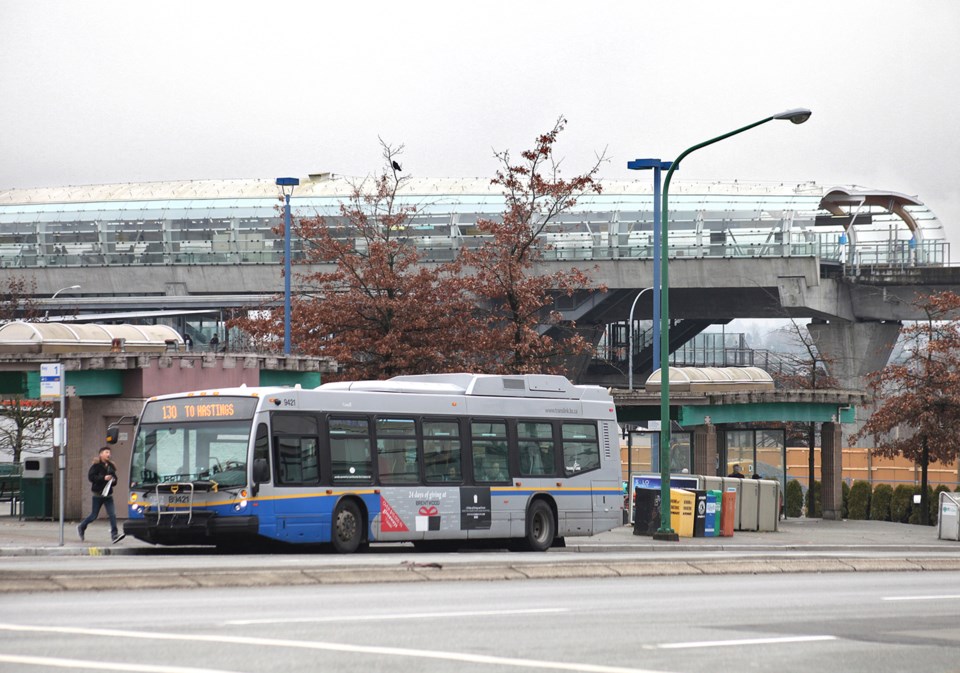As Burnaby prepares for a 61 per cent population spike by 2041, it could inevitably mean the end of bus loops in the ever-urbanizing city.
Bus loops take up a lot of space on land that is increasingly becoming more valuable, and the trend of removing bus loops in Burnaby has already begun at Brentwood Town Centre.
Higher population rates have put pressure on SkyTrain stations to match the volume. As a result, TransLink announced a $164-million project to expand seven of its Expo Line stations, including longer platforms and more access points.
Jeff Busby, senior manager of project development and network management at TransLink, says the transit authority is always reviewing how it uses space, particularly with bus configuration.
“I think we’re seeing the consequence of the region urbanizing,” he told the Burnaby NOW in a phone interview. “It happens with the concentration of growth in town centres, there’s a competing demand on space. Land values get very high as a result. Land changes, just like malls that are replacing surface parking with structure parking and development. We’ve also been asked to do as much as we can with transit services.”
Shape Properties, owner of Brentwood and Lougheed town centres, isn’t alone in removing its bus loop. Lougheed Town Centre’s major redevelopment has cast a questionable future for the bus loop across from the mall, as well. According to a city staff report, a transit hub and plaza are currently part of the redevelopment proposal – complete with an iconic roof, shops and services, a bike service centre and on-street bus stops.
Metrotown SkyTrain is one of the stations already undergoing change, but its bus loop has wired buses that have to stay put, while the diesel buses could go to one of two proposed locations for an exchange near the mall.
A major planning activity for TransLink is also currently underway at the bustling Surrey Central location, with its bus configuration also in question as new proposals are ongoing.
But TransLink wouldn’t confirm if the Lougheed mall and Surrey Central bus loops would remain part of the massive redevelopment planned at either of the busy sites.
One thing TransLink is considering is, rather than owning or leasing chunks of land, it wants to take advantage of the existing urban structures on streets to achieve “urban functionality,” Busby added.
“Buses on city streets benefits customers, as well,” he said. “Basically, loops are isolating. You’re only there waiting for a bus. Putting people closer to shops on the way …. helps customers feel safer. It’s also good for retailers.”
When the 30,000-square-foot loop at Brentwood mall was removed, Busby said the authority looked at reconfiguring the loop. It considered how to put the same functionality in action by how much to integrate it on the streets versus its own property.
But where will bus drivers take a break? Busby says either in alleys or away from busier bus stops – it depends on where TransLink can either acquire land or find a quiet spot for driver respite.
“What happens at a bus loop is the layover time the bus driver uses to get back on schedule, and for buses to take a break, but it takes up a lot of space,” he said. “Basically, it’s a parking space for buses, so what we’re thinking about is … can we separate where layovers take place versus where the passenger picking up takes place?”
For example, downtown Vancouver has no bus loop, and most of the activity is on city streets, Busby noted.
Simon Fraser University’s Gordon Price, a former Vancouver city councillor who was heavily involved with TransLink for a time, says maximizing the impact of transit and return on land use is ultimately what transit is about.
“When you think about … bus exchange buses roaring in and out, it’s not a very pedestrian-friendly environment,” he said. “Look at the transition that’s going to be made at Metrotown, it’s a bleak environment, and it is awful. … It feels like garages. It’s clear it was never designed to be pedestrian-friendly urban environments.”
Gordon said the lack of bus loops in Vancouver helped develop commercial hubs by keeping people on streets where businesses could take advantage of the extra foot traffic.
“In some circumstances, bus loops do make sense,” he said. “Vancouver is blessed, we never built bus loops in the streetcar era, it’s the best urban design we came up with, in my opinion. That’s why we have streetcar villages like Commercial, Robson (and) Denman. All were created by the streetcar system. People walk to get to their stops somewhere along the streets where they can also do their (shopping). It created a healthy urban environment.”
As suburban areas become more urbanized, transit orientation is also changing. Most Burnaby redevelopment proposals include cyclist- and pedestrian-friendly focuses.
Gordon noted that while Burnaby has already grown with bus loops, the opportunity to remove loops can happen easily alongside major redevelopment.
However, the Brentwood mall bus loop removal came with much controversy. Coun. Sav Dhaliwal and some local residents were up in arms about the change to on-street stops, and residents questioned the safety of people with mobility issues accessing stops that were farther away.
Mayor Derek Corrigan questioned the merit of the consultation process about the SkyTrain redevelopment at Metrotown including the bus loop move, and called it frustrating.
In the end, Busby says it’s about making the best use of space. Whether that means bus loops have a future in Burnaby or not, it depends on the growing population’s needs.
“It’s mostly about trying to be efficient with space as our region gets denser,” he said. “We have to be as efficient with space as possible.”



